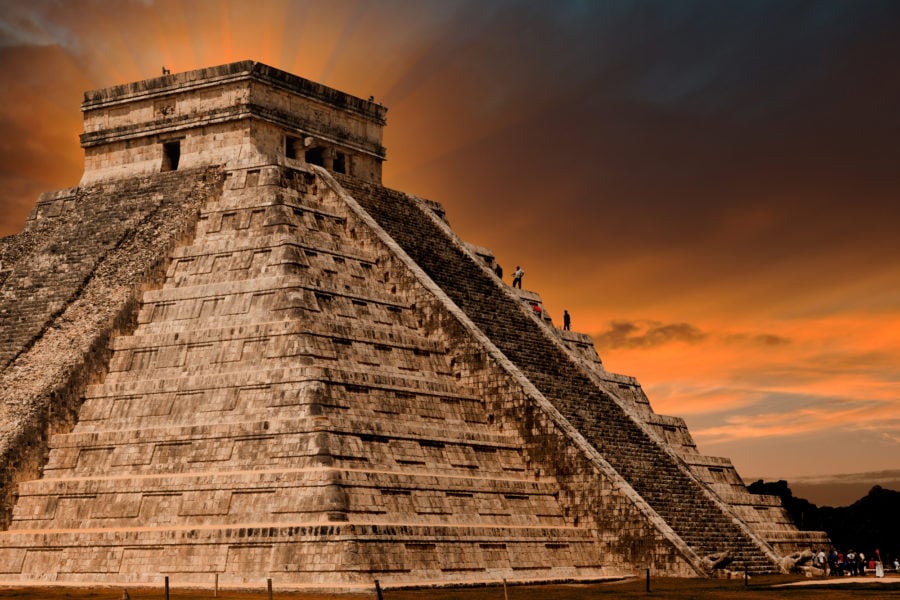Uno de los lugares más maravilloso de México y del mundo entero es la pirámide de Chichén Itzá, te decimos cómo y para qué la construyeron los mayas
Una de las maravillas del mundo se encuentra al sur de México en el oriente de Yucatán. Esta hermosa zona arqueológica ha sido explorada miles de veces por los más grandes historiadores y arqueológos y aún así sigue guardando grandes secretos que giran, principalmente, a su imponente construcción central, la pirámide dedicada al dios Kukulcán.
Si bien aún no hay datos concretos en torno a la época en qué se edificó la pirámide, la cual es conocida a nivel mundial por el fenómeno de luz que se registra en ella durante el equinoccio sí se vislumbra que fue después del período clásico maya.
Cómo y para qué se construyó la pirámide de Chichén Itzá
De acuerdo a la información de cómo se construyó la pirámide de Chichén Itzá con la que se cuenta, el diseño de la forma geométrica piramidal cuenta con nueve niveles, cuatro frentes principales cada uno con su respectiva escalinata central. Con esta construcción se le rindiío culto a Kukulcan, dios maya. Su nombre significa “Serpiente Emplumada”, razón por la que se pueden observar unas serpeintes desciendo en la escalinata principal.
Cada escalinata tiene 91 peldaños que sumados a la de la entrada del templo superior equivalen a los 365 días del año. Por lo que algunos expertos piensan que es posible que la Pirámide de Chichén Itzá se haya edificado con el fin de adorar al sol y marcar la pauta para llevar el control del tiempo cíclico.
Las nuevas observaciones confirman que la pirámide fue orientada para servir como marcador astronómico a partir del cual los mayas juastaban su calendario, así lo informa el Instituto Nacional de Antropología e Historia (INAH).
Durante un evento del equinoccio anual, Ismael Arturo Montero García se percató que la alineación hacia el ocaso desde la escalinata oeste de la pirámide obteniendo un dato extraordinario: El Castillo apunta al ocaso del paso cenital con sólo un grado de desviación respecto a la entrada del cenote Holtún.
INGLES
One of the most wonderful places in Mexico and the entire world is the pyramid of Chichén Itzá, we tell you how and why the Mayans built it
One of the wonders of the world is located south of Mexico in the east of Yucatán. This beautiful archaeological area has been explored thousands of times by the greatest historians and archaeologists and yet continues to keep great secrets that mainly revolve around its imposing central construction, the pyramid dedicated to the god Kukulcán.
Although there is still no concrete data regarding the time when the pyramid was built, which is known worldwide for the light phenomenon that is recorded in it during the equinox, it is apparent that it was after the classic Mayan period.
How and why the pyramid of Chichén Itzá was built
According to the information available on how the pyramid of Chichén Itzá was built, the design of the geometric pyramidal shape has nine levels, four main fronts, each with its respective central staircase. With this construction, Kukulcan, the Mayan god, was worshiped. Its name means “Feathered Serpent”, which is why you can see some snakes descending on the main staircase.
Each staircase has 91 steps that, added to the entrance to the upper temple, are equivalent to 365 days of the year. Therefore, some experts think that it is possible that the Pyramid of Chichén Itzá was built in order to worship the sun and set the tone for keeping track of cyclical time.
The new observations confirm that the pyramid was oriented to serve as an astronomical marker from which the Mayans based their calendar, as reported by the National Institute of Anthropology and History (INAH).
During an event of the annual equinox, Ismael Arturo Montero García noticed that the alignment towards the sunset from the west staircase of the pyramid obtained an extraordinary fact: El Castillo points to the sunset of the zenith passage with only one degree of deviation with respect to the entrance of the Holtún cenote.

